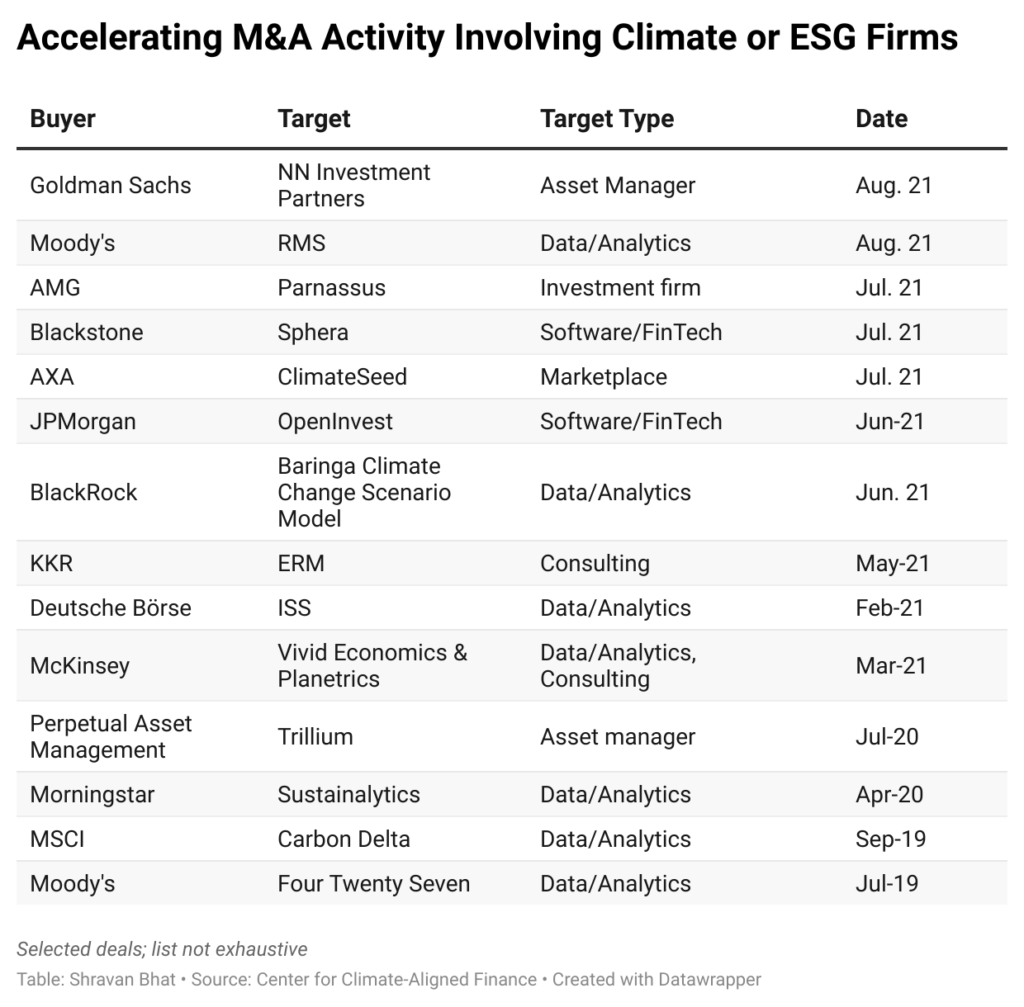
Financing 1.5°C: What’s Driving ESG-Related Mergers?
The investment bank Goldman Sachs recently announced it would pay $1.9 billion for Dutch asset manager NN Investment Partners. In explaining the purchase, Goldman’s CEO David Solomon said that “they have been successful in integrating sustainability, which mirrors our own level of ambition to put responsible investing and stewardship at the heart of our business.”
It is Solomon’s biggest acquisition since he took charge of Goldman in 2018. It is also the latest in an accelerating trend of corporate mergers and acquisitions (M&A). Financial sector heavyweights are increasingly buying up smaller firms with expertise in climate, sustainability, or the environmental, social, and governance (ESG) domain (see table below).
What is driving this wave of climate-flavored M&A? What’s behind this hunt for ESG expertise? At RMI’s Center for Climate-Aligned Finance, we see a few connected themes. First, this summer’s upsurge in M&A activity seems largely fueled by bigger firms looking to improve their understanding and analytical capabilities related to climate risk. Second, and more importantly, the ecosystem for climate alignment (the process of bringing the global economy’s emissions in line with 1.5°C temperature targets) appears to be where the climate risk ecosystem was three to five years ago. So, can we expect a similar hunt for proprietary data and capabilities relating to climate alignment in the near future?
Climate Risk: Understanding What Might Happen
In the past few years, financial institutions have dedicated increasing resources to climate risk—both physical risks from climate change and transition risks from being left behind in the impending energy revolution. In 2017, the Financial Stability Board’s Task Force on Climate-Related Financial Disclosures (TCFD) released its recommendations for climate-related disclosures.
Financial sector leaders welcomed this voluntary disclosure framework, which has been met with commitments to align with the recommendations over time. TCFD disclosure is already mandatory in New Zealand and soon will be across the UK, Switzerland, Hong Kong, and other jurisdictions as well. As climate-related financial risks materialize, financial regulation on climate also becomes a more prominent issue for chief risk officers.
Global financial institutions face two major hurdles as they seek to understand climate risk. The first is a lack of high-quality data about companies’ current and future resilience to climate risk. The second hurdle is being able to overlay this data with forward-looking climate scenarios and plug the outcomes into existing risk frameworks and models.
Firms generally have three main avenues to source and analyze this risk data. They can develop the expertise in-house, buy the information from data providers, or buy smaller firms that specialize in climate risk. With the abundance of capital available in the market today, many large firms are opting for the latter and taking the M&A route.
The recent M&A deals vary in size and structure, and the target companies span a range of expertise. But risk analytics is emerging as a common trait as global financial institutions (and data providers) compete to offer the best products to their increasingly climate-focused clients. For example, risk and ratings giant Moody’s announced this month that it would purchase climate risk analysis firm RMS for $2 billion. Meanwhile, BlackRock is buying a climate scenario model from Baringa, a business and technology consultancy firm.
Climate Alignment: Understanding What Should Happen
The next frontier beyond what might happen is asking what should happen. Financial institutions are critical to the success of the energy transition and meeting global climate goals. For this reason, we foresee a chain of events, similar to the one playing out in the climate risk space, that focuses on voluntary commitments to align lending and investing portfolios with net zero.
With the proliferation of net-zero targets among global financial institutions, bolstered by frameworks and initiatives such as the Net-Zero Banking Alliance and its target-setting guidelines, a familiar conundrum arises. Namely, how can financial firms get high-quality data and analytical capabilities that will allow users to effectively support clients and inform lending and investment decisions? We expect to see increased interest from financial firms in building or acquiring the technology, data, and expertise to support climate alignment efforts.
The consolidation in climate data and expertise—especially within the financial sector—raises another key question: to decarbonize the global economy by 2050, what climate data should be proprietary and what should be public? Where is the sweet spot between private information that financial institutions use to compete and innovate versus the public information that the entire market should have access to? As we monitor where this line between public and private data is being drawn, staff at the Center are also weighing where it should be drawn.
Looking Ahead
At the moment, though, there is a lack of consistent, transparent data across the board. Regulators are working to address this barrier with new rules around climate change disclosures, which have been proposed by the US Securities and Exchange Commission (SEC) and the European Commission. Financial sector participants have expressed widespread support for the SEC or a similar body mandating climate-related disclosures.
Based on that support, the Center currently sees the need for establishing a standardized, transparent baseline of corporate climate data. In other words, companies’ climate-relevant data (e.g., their emissions, strategies, asset bases, and capital expenditure plans) could become the “plumbing beneath the streets” that all firms can use and share. The analytical tools and teams that firms build aboveground, using that “plumbing,” is perhaps what will give them the competitive edge and help them attract and retain the most climate-conscious clients.
So while we might expect the current M&A trend to carry over into climate alignment data and capabilities, we should ask ourselves whether acquisitions will patch up or clog the pipes for the flow of finance (and data) to where it’s needed most. But in the meantime, with corporate profits at record highs and plenty of “dry powder” available for acquisitions, it does not look like the climate M&A frenzy will die down any time soon.
